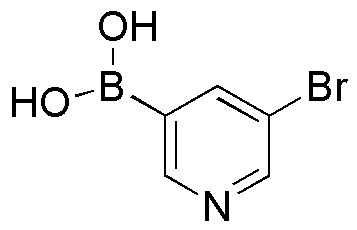5-Bromopyridine-3-boronic acid is widely utilized in research focused on:
- Pharmaceutical Development: This compound is crucial in synthesizing various pharmaceuticals, particularly in creating targeted therapies for diseases like cancer. Its boronic acid functionality allows for the formation of stable complexes with biomolecules.
- Organic Synthesis: It serves as a versatile building block in organic chemistry, facilitating the development of complex organic molecules. Researchers often use it in Suzuki coupling reactions, which are essential for creating carbon-carbon bonds.
- Agricultural Chemistry: The compound is explored for its potential in developing agrochemicals, including herbicides and pesticides, which can enhance crop protection and yield.
- Material Science: It is applied in the creation of advanced materials, such as polymers and nanomaterials, where its unique properties can improve material performance and functionality.
- Diagnostic Tools: The compound is being investigated for use in diagnostic applications, particularly in the development of sensors that can detect specific biomolecules, aiding in early disease detection.
General Information
Properties
Safety and Regulations
Applications
5-Bromopyridine-3-boronic acid is widely utilized in research focused on:
- Pharmaceutical Development: This compound is crucial in synthesizing various pharmaceuticals, particularly in creating targeted therapies for diseases like cancer. Its boronic acid functionality allows for the formation of stable complexes with biomolecules.
- Organic Synthesis: It serves as a versatile building block in organic chemistry, facilitating the development of complex organic molecules. Researchers often use it in Suzuki coupling reactions, which are essential for creating carbon-carbon bonds.
- Agricultural Chemistry: The compound is explored for its potential in developing agrochemicals, including herbicides and pesticides, which can enhance crop protection and yield.
- Material Science: It is applied in the creation of advanced materials, such as polymers and nanomaterials, where its unique properties can improve material performance and functionality.
- Diagnostic Tools: The compound is being investigated for use in diagnostic applications, particularly in the development of sensors that can detect specific biomolecules, aiding in early disease detection.
Documents
Safety Data Sheets (SDS)
The SDS provides comprehensive safety information on handling, storage, and disposal of the product.
Product Specification (PS)
The PS provides a comprehensive breakdown of the product’s properties, including chemical composition, physical state, purity, and storage requirements. It also details acceptable quality ranges and the product's intended applications.
Certificates of Analysis (COA)
Search for Certificates of Analysis (COA) by entering the products Lot Number. Lot and Batch Numbers can be found on a product’s label following the words ‘Lot’ or ‘Batch’.
*Catalog Number
*Lot Number
Certificates Of Origin (COO)
This COO confirms the country where the product was manufactured, and also details the materials and components used in it and whether it is derived from natural, synthetic, or other specific sources. This certificate may be required for customs, trade, and regulatory compliance.
*Catalog Number
*Lot Number
Safety Data Sheets (SDS)
The SDS provides comprehensive safety information on handling, storage, and disposal of the product.
DownloadProduct Specification (PS)
The PS provides a comprehensive breakdown of the product’s properties, including chemical composition, physical state, purity, and storage requirements. It also details acceptable quality ranges and the product's intended applications.
DownloadCertificates of Analysis (COA)
Search for Certificates of Analysis (COA) by entering the products Lot Number. Lot and Batch Numbers can be found on a product’s label following the words ‘Lot’ or ‘Batch’.
*Catalog Number
*Lot Number
Certificates Of Origin (COO)
This COO confirms the country where the product was manufactured, and also details the materials and components used in it and whether it is derived from natural, synthetic, or other specific sources. This certificate may be required for customs, trade, and regulatory compliance.


